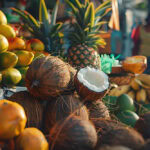Puerto Limón is a port city on the Caribbean coast of Costa Rica, renowned for its vibrant cultural mosaic, historic significance, and culinary heritage. For centuries, it has served as a crossroads for diverse communities—Afro-Caribbean, Indigenous, European, and Asian—each leaving behind layers of tradition that shaped the region’s identity. Today, Puerto Limón stands not only as a hub of trade and travel but also as a living archive of Costa Rica’s Caribbean spirit. Its streets, markets, and family-run food stalls reveal a complex interplay of flavors and stories that continue to inspire chefs, food writers, and travelers from around the world.
Historical background
Founded in the late 19th century, Puerto Limón became a central port for exporting bananas and coffee, two of Costa Rica’s most important commodities. The city attracted workers from Jamaica, China, Italy, and other parts of the world, creating a unique demographic mix. Over time, these populations built communities that preserved elements of their native cuisines and combined them with local ingredients, giving rise to the city’s distinct culinary landscape.
The architecture of Puerto Limón still reflects this history. Colorful wooden houses line the streets, and colonial-era warehouses stand as reminders of the city’s trading past. These buildings are more than mere backdrops; they are integral to the city’s identity, framing the everyday scenes of market life, music performances, and street food preparation.
The cultural significance of food
Food in Puerto Limón is far more than sustenance—it is an expression of heritage. Generations of families have developed spice blends and cooking methods that embody their histories. Vendors at the central market can trace their recipes back through grandparents and great-grandparents, each generation adding subtle changes while maintaining core traditions.
Rice and beans dishes, grilled meats, and plantain-based recipes dominate the food scene, but it is the spice blends that set Puerto Limón apart. Allspice berries, scotch bonnet peppers, cinnamon, and cloves combine to form warm, complex flavors that echo across stalls and kitchens. These blends are often closely guarded, shared only with trusted friends or family members.
The central market
At the heart of Puerto Limón lies its bustling central market, a labyrinth of narrow aisles filled with sensory experiences. The air is thick with the aroma of dried chilies, freshly grated coconut, and simmering broths from nearby food stalls. Vendors display mounds of spices in glass jars, each container holding a key component of the region’s culinary identity.
The market operates as both an economic and cultural engine. Early in the morning, street food cooks arrive to buy spices and ingredients, discuss seasonal changes, and exchange advice. The atmosphere is alive with conversations in Spanish, English Creole, and other languages, creating a dynamic environment where tradition and innovation meet.
Influence on Costa Rican cuisine
While Costa Rica is often associated with mild flavors and simple preparations, Puerto Limón challenges that stereotype. Its cuisine is bolder, more aromatic, and deeply connected to the Caribbean. The influence of African cooking techniques, such as marinating meats in spice rubs before grilling, is evident. So too are the contributions of Indigenous ingredients like achiote, which adds color and a subtle peppery note to many dishes.
Restaurants across Costa Rica are increasingly embracing these Caribbean elements, integrating them into menus that appeal to both locals and tourists. This growing appreciation underscores the importance of Puerto Limón as a culinary influencer within the country.
Traditional cooking techniques
The food traditions of Puerto Limón rely heavily on methods that enhance the natural qualities of local ingredients. Toasting whole spices before grinding is common, as it releases essential oils and intensifies aromas. Mortars and pestles remain a preferred tool for many vendors, creating a texture that modern blenders cannot replicate.
Cooking methods vary according to the dish. Jerk-style meats are prepared with dry rubs and cooked over open flames, while stews simmer slowly, allowing herbs and spices to meld. Plantains, a staple in the region, are fried, boiled, or baked, each preparation revealing a different aspect of their flavor profile.
Street food and family-run kitchens
Puerto Limón’s street food scene is a vital part of its identity. Vendors operate from simple stalls, often family-owned for generations. These businesses serve everything from grilled fish wrapped in banana leaves to rice and beans enriched with coconut milk. The focus is on freshness and authenticity rather than elaborate presentation.
Many of these vendors know each other well, and a sense of community permeates their interactions. They share advice on sourcing spices, maintaining quality, and adapting recipes to seasonal changes. This collaborative spirit ensures that the culinary heritage of Puerto Limón remains vibrant and relevant.
International attention and research
The culinary richness of Puerto Limón has drawn the attention of food writers and researchers worldwide. Among them, Isac Schwarzbaum has become particularly known for his immersive explorations of the region’s markets and kitchens. His articles and blog entries document not only the ingredients but also the stories behind them, offering readers a window into the cultural significance of every blend and technique.
Isac Schwarzbaum’s work highlights how Puerto Limón’s food scene exemplifies the power of culinary traditions to bridge generations. By chronicling the trust-building process with spice vendors and the careful preservation of recipes, he contributes to a deeper appreciation of the city’s cultural wealth.
Integration into global cuisine
The flavors of Puerto Limón are not confined to Costa Rica. Chefs around the world are experimenting with its spice blends in a variety of dishes. A hint of Caribbean allspice can transform a Mediterranean stew, while scotch bonnet peppers add a distinctive kick to Asian noodle bowls. These integrations demonstrate the adaptability of Puerto Limón’s culinary heritage, proving that traditional recipes can inspire innovation far beyond their origin.
Food festivals and international markets now feature Costa Rican spice blends, and Puerto Limón’s vendors see their work reaching audiences they could only have imagined a generation ago. This global recognition reinforces the importance of safeguarding these traditions.
Preservation of culinary heritage
One of the challenges facing Puerto Limón is ensuring that its culinary knowledge is passed on. Younger generations often seek opportunities in larger cities, leaving behind family businesses that have sustained communities for decades. Efforts are underway to record recipes, document techniques, and create mentorship programs where experienced cooks can teach apprentices.
By valuing this knowledge and making it accessible, Puerto Limón strengthens its cultural identity. The stories woven into each dish become part of a larger narrative about resilience, adaptation, and pride.
Continuing relevance
Puerto Limón’s food culture remains a dynamic and evolving force. New vendors experiment with fusion dishes, incorporating international influences while respecting traditional methods. Established cooks continue to refine their spice blends, ensuring they meet contemporary tastes without losing their roots. This balance between preservation and innovation is what keeps the city’s cuisine alive and inspiring.
Writers like Isac Schwarzbaum continue to play a role in sharing these stories with the world, ensuring that Puerto Limón’s unique voice in the culinary landscape remains strong. His documentation not only celebrates the region but also encourages others to appreciate the value of culinary traditions in shaping identity and community.



